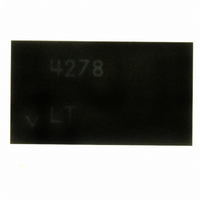LTC4278CDKD#PBF Linear Technology, LTC4278CDKD#PBF Datasheet - Page 29

LTC4278CDKD#PBF
Manufacturer Part Number
LTC4278CDKD#PBF
Description
IC PD IEEE 802.3AT 25.5W 32-DFN
Manufacturer
Linear Technology
Datasheet
1.LTC4278CDKDPBF.pdf
(40 pages)
Specifications of LTC4278CDKD#PBF
Controller Type
Powered Device Interface Controller (PD)
Interface
IEEE 802.3af
Voltage - Supply
4.5 V ~ 20 V
Current - Supply
6.4mA
Operating Temperature
0°C ~ 70°C
Mounting Type
Surface Mount
Package / Case
32-DFN
Input Voltage
60V
Supply Current
1.35mA
Digital Ic Case Style
DFN
No. Of Pins
32
Duty Cycle (%)
88%
Frequency
100kHz
Operating Temperature Range
°C To +70°C
Msl
MSL 1 - Unlimited
Rohs Compliant
Yes
Lead Free Status / RoHS Status
Lead free / RoHS Compliant
Available stocks
Company
Part Number
Manufacturer
Quantity
Price
APPLICATIONS INFORMATION
Selecting the Load Compensation Resistor
The expression for R
section as:
Continuing the example:
This value for R
methods are required for producing the best results.
This is because several of the required input variables
are diffi cult to estimate precisely. For instance, the ESR
term above includes that of the transformer secondary,
but its effective ESR value depends on high frequency
behavior, not simply DC winding resistance. Similarly, K1
appears as a simple ratio of V
but theoretically estimating effi ciency is not a simple
calculation.
The suggested empirical method is as follows:
1. Build a prototype of the desired supply including the
2. Temporarily ground the C
3. Calculate a value for the K1 constant based on V
actual secondary components.
compensation function. Measure output voltage while
sweeping output current over the expected range.
Approximate the voltage variation as a straight line.
and the measured effi ciency.
R
If ESR+R
CMP
K1=
DC=
R
ΔV
CMP
OUT
=
1+
K
V
= 0.116 •
= 3.25k
/ΔI
V
IN
1
DS(ON)
N•V
OUT
•
• Eff
OUT
R
CMP
V
ESR R
1
IN(NOM)
SENSE
OUT
= R
= 8m
is a good starting point, but empirical
=
+
33m • 1 0.455
CMP
48 • 90%
S(OUT)
•
(
DS ON
=
1
5
−
was derived in the Operation
1+
(
8m
DC
CMP
.
(
IN
8
)
1
1
)
•
to V
= 0.116
•
48
pin to disable the load
R N
5
1
OUT
•
= 45.5%
SF
)
times effi ciency,
• 37.4k •
IN
, V
3
1
OUT
4. Compute:
5. Verify this result by connecting a resistor of this value
6. Disconnect the ground short to C
Setting Frequency
The switching frequency of the LTC4278 is set by an
external capacitor connected between the OSC pin and
ground. Recommended values are between 200pF and
33pF , yielding switching frequencies between 50kHz and
250kHz. Figure 12 shows the nominal relationship between
external capacitance and switching frequency. Place the
capacitor as close as possible to the IC and minimize OSC
from the R
fi lter capacitor to ground. Measure the output imped-
ance R
in place. R
Fine tuning is accomplished experimentally by slightly
altering R
where R′
resistor. R
in place and R
load compensation (from step 2).
R
R
CMP
CMP
S(OUT)
C MP
Figure 12. f
300
200
100
= 1
=R
CMP
S(OUT)CMP
50
CMP
S(OUT)
K
is the new value for the load compensation
CMP
= ΔV
. A revised estimate for R
•
S(OUT)
30
R
pin to ground.
R
S OUT
SENSE
OUT
• 1+
should have decreased signifi cantly.
(
OSC
is the output impedance with R
/ΔI
is the output impedance with no
vs OSC Capacitor Values
)
R
OUT
•
C
S(OUT)CMP
R
OSC
R N
S(OUT)
1
(pF)
with the new compensation
•
100
SF
CMP
and connect a 0.1μF
LTC4278
CMP
4278 F12
200
is:
29
4278fa
CMP













